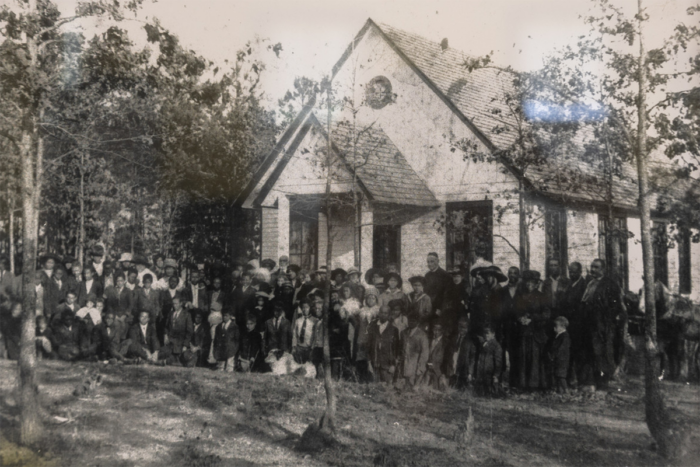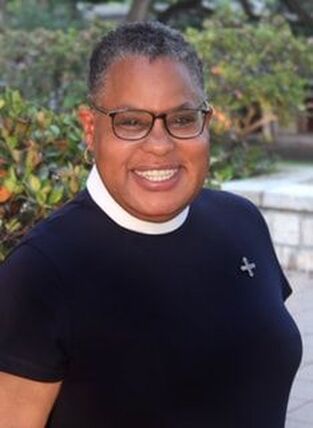Western North Carolina pilgrimage to amplify historically Black churches’ storiesPosted Feb 23, 2023 |
|

Parishioners pose for a photo in front of St. Gabriel’s Episcopal Church in Rutherfordton, North Carolina, likely in the first years after the church was built in 1915. Photo: Barrier Breakers/Diocese of Western North Carolina
[Episcopal News Service] The people and stories of seven historically Black churches in the Diocese of Western North Carolina will be highlighted Feb. 25 during a diocesan pilgrimage that takes its lead from Barrier Breakers, an ongoing racial healing storytelling project.
As Black History Month winds down, Episcopalians in the Asheville-based diocese are encouraged to visit one or more of the churches featured on the Barrier Breakers website, and local church leaders and longtime parishioners will be on hand to welcome them, share stories of the churches’ past and answer questions. Episcopalians who don’t live in or near Western North Carolina still can learn about the pilgrimage sites online.
Western North Carolina Bishop José McLoughlin, who has encouraged the diocese to engage in racial reconciliation work since his consecration in 2016, is scheduled to lead a small group that will visit several of the historically Black churches during the daylong pilgrimage. McLoughlin said such efforts reflect the diocese’s emphasis on the churchwide Becoming Beloved Community initiative, which is structured around four commitments: telling the truth, repairing the breach, practicing the way and proclaiming the dream.
The Barrier Breakers project serves that mission because “Beloved Community is about storytelling,” McLoughlin told Episcopal News Service in an interview this week. “First you have to tell stories before you can dream.” The term Beloved Community was popularized by the Rev. Martin Luther King Jr. to represent his vision for a society lifted up in racial harmony.
The Barrier Breakers project originated in February 2021 as a limited series of video interviews for Black History Month that year. Archdeacon Brenda Gilbert partnered with Virginia Taylor, then the diocese’s communications director, to record the stories of five elder people of color in the diocese about their experiences in the church, including with segregation.
“It was difficult at first,” Gilbert told ENS. “Some of these parishioners are in their 80s, and they’ve seen and gone through a lot.” She was grateful that they were willing to tell their stories for the diocese to hear, and after that first series of videos, the diocese recorded additional video interviews that were released later that year.
Gilbert, though, sensed a need to do more, and she asked the bishop and other diocesan leaders, what now? At that time, Episcopalians across the church had been embarking on various civil rights pilgrimages to places like Montgomery, Alabama, and Gilbert proposed creating opportunities for a racial healing pilgrimage within their own diocese.
“It was just asking, what happened here? That opened up everything,” she said, because they found that there were many more stories to tell about the history of the diocese’s historically Black churches. “The impact that the parishes had on whole communities, it’s amazing.”
In Rutherfordton, for example, the historic St. John’s Church was built by enslaved Black laborers in the late 1840s, and only white residents were recorded as church members. In 1900, the growing congregation of white Episcopalians established a new church, St. Francis, on Main Street and would not let the Black community worship there. Instead, Black Episcopalians gathered for worship in house churches at first and then, starting in 1915, in the newly built St. Gabriel’s Episcopal Church in on Ridgecrest Avenue.

The Rev. Toni Belhu serves St. Francis and St. Gabriel’s Episcopal churches in Rutherfordton, North Carolina. Photo: St. Francis
Today, St. Francis and St. Gabriel’s both have the same rector, the Rev. Toni Belhu, who also became St. Francis’ first Black rector when she was called in July 2021. Belhu told ENS that St. Gabriel’s historically was and continues to be “a community gathering place” for residents of the New Hope neighborhood.
Some of those stories are available on the Barrier Breakers website, with a map showing St. Gabriel’s and St. Francis’ locations, current and historical photos of the churches, articles about Rutherfordton’s history, a list of additional resources and a 19-minute audio clip that mixes local history with parishioners sharing their memories of St. Gabriel’s.
The other active churches on the Barrier Breakers pilgrimage are St. Matthias Episcopal Church in Asheville, St. Stephen’s Episcopal Church in Morganton, Good Shepherd Episcopal Church in Tryon and St. Cyprian’s Chapel in Franklin. The pilgrimage includes two additional sites that once were home to St. Cyprian’s Episcopal Church in Lincolnton and St. Barnabas Episcopal Church in Murphy, though there no longer are active congregations there.
The page featuring St. Barnabas includes audio from an interview with the last surviving member of that parish, who died late last year, Gilbert said.
Visitors who embark on the Feb. 25 pilgrimage are welcome to bring their smartphones, so they can listen to the audio clips and research the churches’ histories on their own. They also can participate in some of the activities that are planned at each of the seven sites to enrich visitors’ understanding of the history.
“There’s something about being in that space and feeling the spirit of those people who dedicated their lives to those communities,” said Gilbert, who is based in Gastonia and serves at St. Mark’s Episcopal Church.
St. Gabriel’s is planning to host McLoughlin for lunch during his group’s pilgrimage stop there. Church members will be on hand to interact with visitors, including the granddaughter of one of St. Gabriel’s founders, who hosted the early house worship services.
McLoughlin said he isn’t planning any official actions as bishop during the pilgrimage, preferring to keep the focus on the churches and their stories. “I’m one of these people on the journey,” he said, though he hopes others will join him in following the pilgrimage, either in person or online.
Such deliberate listening to our shared history opens up “amazing possibilities,” he said, “because we are collectively dreaming together, hearing those stories, hopefully being transformed by those stories.”
– David Paulsen is an editor and reporter for Episcopal News Service. He can be reached at dpaulsen@episcopalchurch.org.

Social Menu